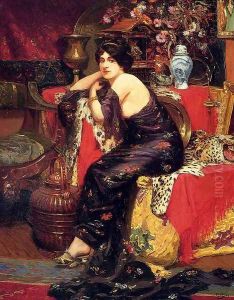Frederic Louis Leve Paintings
Frédéric Louis Lévê, born in 1819 and passing away in 1897, was a French painter and illustrator known for his contributions to landscape and marine painting. Despite not being as widely recognized as some of his contemporaries, Lévê's work provides a fascinating insight into the 19th-century French art scene, reflecting the shifts in artistic styles and interests of his time.
Lévê's early life is somewhat obscure, but it is known that he was born in France and received his artistic training in Paris. He was a student of the Ecole des Beaux-Arts, where he studied under prominent artists of the period. This education provided him with a solid foundation in the techniques and principles of traditional French art, which he would later adapt and evolve in his personal style.
Throughout his career, Lévê was particularly drawn to capturing the natural world, focusing on landscapes and sea scenes. His works often depicted the French countryside and coastal areas, capturing the changing lights and moods of these scenes with a delicate sensitivity. Lévê's landscapes are characterized by their serene beauty and a meticulous attention to detail, while his marine paintings capture the dynamic power and vastness of the sea.
Despite his talent, Frédéric Louis Lévê did not achieve the same level of fame as some of his peers. However, his contributions to French art have been recognized by art historians and collectors, especially in the context of the development of landscape and marine painting in the 19th century. Lévê exhibited his work at various salons and galleries throughout his career, receiving positive critiques for his ability to convey emotion and atmosphere in his paintings.
Today, Lévê's works can be found in private collections and occasionally in museums, where they are appreciated for their contribution to the rich tapestry of French art. His paintings continue to be studied for their technique, composition, and the unique perspective they offer on the natural world, marking him as an important, if underappreciated, figure in the history of French painting.
